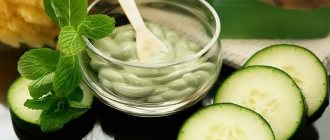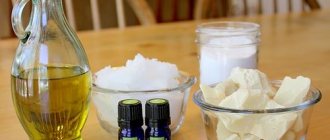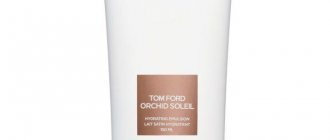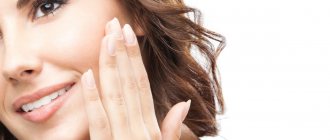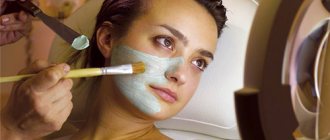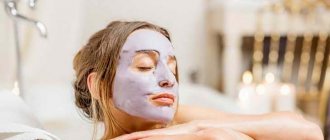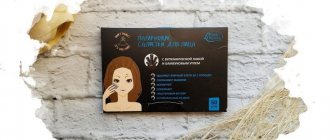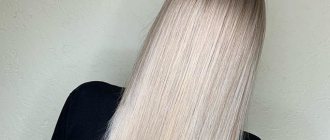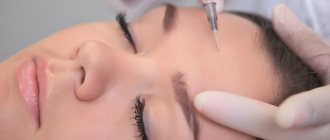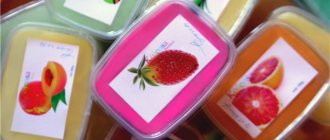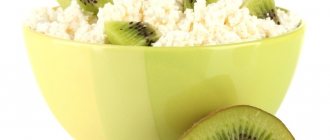How to exfoliate before and after tanning at home?
The content of the article:
- Benefits of peeling
- When can you peel?
- Peeling and tanning in the solarium
- Contraindications
- How to do it right
Exfoliating before or after tanning is a great way to protect your skin, get better results, and maintain them longer. This procedure can easily be carried out at home using various natural herbal remedies. It is simple, does not require a lot of time and significant financial costs, especially since there are many different recipes for this. You will be able to notice the benefits of the procedures very soon, literally 7-10 days after the start of the course. Naturally, the need for this arises in two cases - before a trip to the sea or before visiting a solarium.
Revitalizing skin masks
After sunbathing, you need to help your facial skin recover. It is possible for the immune system to cope with this on its own, but it is problematic and takes a long time. The following recipes are suitable as restorative masks:
- mash 10 blueberries (you can use frozen ones) and mix with a tablespoon of natural yogurt;
- Strawberries are pureed (3 tablespoons) and mixed with a small amount of honey (maximum 1 teaspoon);
- The egg white is whipped into a stable foam, half a teaspoon of powdered sugar and 2 teaspoons of honey are added to it.
Revitalizing face masks after sunbathing
These revitalizing masks are applied to the face for 20 - 30 minutes. When choosing a specific recipe, you need to take into account the hyperallergenic nature of some products. For example, strawberries, honey and blueberries can only add to the problems. The course of restorative procedures for skin after sunbathing is 15 with a break of 2 - 3 days.
We recommend reading about express face masks. You will learn about the principle of operation of express masks, rules of use, and recipes for preparing at home. Find out more about the best facial moisturizers here.
Tanning is beautiful and attractive, but you must take care of the health of your facial skin. She already gets maximum stress every day, so additional care for her will only be beneficial.
Benefits of peeling for tanning
To tan more evenly, the skin must be clean. To do this, it is necessary to regularly remove dead particles and dirt from it. For this purpose, home or salon peeling products are used to exfoliate dead cells.
Benefits come from both superficial peeling, as well as medium and deep peeling. But it will be noticeable only if the tissues are thoroughly pre-moistened with cream, otherwise irritation, itching, and redness may occur. The fatter it is, the better and safer the procedure will be.
Exfoliating after sunbathing is no longer necessary, but it is advisable. This is due to its positive effect on the skin - eliminating the negative effects of exposure to sunlight. These include age spots, peeling, redness, irritation, and dryness. But first of all, tissue cleansing helps prevent photoaging, which is caused by prolonged exposure to UV rays. If this is not done, wrinkles may appear on the face much faster.
Peeling is also useful because it protects against the development of skin cancer. It restores its firmness and elasticity, prevents rosacea from progressing, evens out the surface texture and lightens areas with uneven color, where the tan is not the best. With its help, the regeneration process is also accelerated by improving blood circulation. In addition, the renewal of dead cells is activated, which also has a beneficial effect on tissue restoration.
When can you exfoliate before and after tanning?
In order to get good results, after cleansing the skin, about 10 days should pass before sunbathing. This period is conditional, the main thing is that she calms down and recovers from the stress she has experienced, which in the absence of such a break can only intensify.
If superficial body peeling is carried out before tanning using coffee, oatmeal and other natural remedies, then sunbathing can be done 4-5 days after that. But for salon procedures, for example, ultrasound, medium and deep procedures, there are restrictions of 2-3 weeks.
The deeper the product penetrates into the tissue, the longer the interval between sunbathing and skin cleansing should be. If the procedure has side effects, then you can start tanning only when the damaged tissues have completely healed. The fact is that UV rays can slow down recovery after damage to the integrity of the integument.
After being exposed to UV rays, which penetrate deep into the tissues, they become thinner, sometimes even suffering from necrosis and severe burns. In this case, naturally, no scrubbing agents should be used until the skin is completely regenerated. This can cause burning, redness and irritation, and cause discomfort.
Sunscreens for tanning - proper use
The best effective product must have both physical and chemical filters.
Physical ones reliably protect the skin from UVB rays, that is, from burns, and chemical ones from UVA rays, from moles, pigmentation, papillomas, premature wrinkles, and cancer.
Choose a product with protection from UVB and UVA rays, without dyes, to avoid allergies. Sunscreens come in different types: creams, milks, sprays, emulsions. If you have dry or normal skin, then choose
creams or milks, sprays, emulsions are suitable for oily and combination skin.
If the label does not indicate that the cream is for face and body, the body cream cannot be used for the face, as it may contain components that are not suitable for the face.
Sun protection is very important. Be sure to use sunscreen when going outside. Even in winter it is necessary to use sunscreen.
Especially people who are on diets, fasting or vegetarians must be protected from the sun, since they have insufficient supply of nutrients in the body, which reduces the skin’s ability to withstand the sun’s rays.
Therefore, before going outside on a clear day, do not forget to apply sunscreen to your skin to protect yourself from premature aging.
Sun filters: physical and chemical
Main types of sun rays:
- UVA long;
- UVB medium;
- UVC is short.
Because when sunlight passes through the atmosphere, almost all UV-C rays are absorbed. Cosmetics manufacturers have focused their efforts on counteracting rays A and B. We owe tanning or sunburn to UBB rays. UVA rays do not leave traces; they penetrate deep into the skin and cause age spots and moles.
UV protection products include physical and chemical filters. Therefore it is necessary
Read the label, physical filters form a protective layer without penetrating or irritating the skin. True, these filters are not waterproof; their protection factor does not exceed 20.
Chemical filters absorb UVB rays and UVA rays, that is, they protect the skin from all types of ultraviolet radiation, thanks to the benzophenone contained in the composition.
The substances in these products penetrate the skin and absorb very harmful radiation, the degree of protection of such products is high. However, they should not be used by children and people with allergies who are prone to the formation of age spots.
To increase the effectiveness of cosmetics, natural filters can also be added to the composition - peach oil, shea butter, sesame oil, wheat germ oil, almond oil, jojoba antioxidants, coenzyme Q 10, vitamins C and E, calendula spruce extract, fir pine.
Sun Protection Factor SPF
SPF level of sun cream protection:
- 2-5 small defense;
- 6-11 average;
- 12-19 high;
- more than twenty very high protection
SPF shows how many times a sunscreen can increase the time spent in the sun without causing harm to health.
harm to health.
If you have pale white skin, then after 5 minutes you can already get a burn. SPF 30 cream increases the time to one and a half hours, but you need to take into account the moment of first application. Repeated application of the cream will not prolong the effect, but only increase reliability.
In order for the drug to show its protective properties in the best possible way, apply the cream to the face and those areas of the body that are open half an hour before leaving the house.
Many people believe that it is enough to buy a low level of protection and apply two layers of cream - this is a mistaken opinion. A couple of layers of SPF 10 cream will give you SPF 10 protection, not 20.
Conclusion: unfortunately, the answer to the question: is sunbathing harmful? the answer will be: yes, sunbathing is harmful. But by protecting your skin with sunscreen, you minimize the harmful effects of UV rays and gain golden, even, beautiful skin color.
Is it possible to combine peeling and tanning in a solarium?
Unlike the sun, a solarium greatly expands pores and further increases skin sensitivity. After his visit, she becomes very susceptible to the effects of various cosmetics, especially those intended for peeling. Even delicate scrubs designed specifically for those with delicate and problematic skin will not save you here. Therefore, there is only one conclusion: you need to wait at least a month before getting a beautiful tan. This way it will be safer, more beautiful, and will lie more evenly.
You need to wait the above time both after performing chemical and laser peeling. If this is not done, you can get burns, recovery from which will take a lot of time. An exception here can only be made for a procedure during which only the superficial layer of tissue is affected. In this case, you can limit yourself to a break of 10 days.
Contraindications for peeling before and after tanning
You should not perform this procedure on dry skin, otherwise it may turn red and start to burn. If the composition contains fruit acids, then the use of such products in the presence of acne and open wounds should be avoided.
Body peeling at home before or after tanning should also be postponed in case of fever, viral infections, breastfeeding and pregnancy in the third trimester.
Contraindications to the use of cleansing peeling scrubs are:
- Dermatitis
. This is a skin disease in which a large amount of red rash appears on the body and face. It is usually indicated by severe itching and a great desire to scratch the painful areas.
Psoriasis
. It is better known as lichen planus, which is a non-infectious dermatological disease that has only a chronic form.
Oncological diseases
. An absolute contraindication is skin cancer, and relative contraindications are its other forms. In the latter case, medium and deep peeling should be excluded, while superficial peeling is allowed.
- Allergy to components in the product
. It usually manifests itself in the form of redness of the skin, itching and peeling. In order to exclude this, even before using the composition it is necessary to apply it to the elbow. If there are no consequences, then the procedure can be performed without fear.
How to properly do body peeling at home?
If you don’t want to go to beauty salons and buy special cosmetic products, then you can prepare effective folk remedies yourself based on natural exfoliating ingredients. Anything that can remove dead skin particles is suitable here - sea salt, oatmeal, coffee, mustard and kelp powder, sugar and much more. etc.
To properly prepare the skin for tanning or to consolidate its results, it is enough to complete a course of 10 procedures. The optimal frequency of performing them is 2-3 times a week, at first it is better to limit yourself to 1 time, because the tissues still need time to get used to peeling, which everyone tolerates differently.
BODY TANING AND PEELING. TOP 3 recipes before tanning
After exfoliation, the skin becomes cleaner, fresher, begins to glow with beauty and youth. And, of course, you always want to become even more perfect by exposing your body and face to the sun’s rays, which will give your skin a beautiful caramel shade. But is it possible to sunbathe after peeling?
Most people associate tanning only with a bronzed body. But in fact, tanned skin is our body’s protective reaction to the aggressive effects of ultraviolet rays emitted by the sun. And the main defensive barrier is the cells of the epidermis.
PROS AND MINUSES OF TAN AFTER PEELING
Due to the fact that exfoliation primarily affects the epidermis, its effect on tanning is twofold:
- Removes the upper layers of the skin, which contain the main deposits of melanin;
- Inhibits the formation of melanin.
On the one hand, the tan lasts longer after the horn cells are exfoliated and goes on more evenly. This happens because there are no sharp changes in pigment on the surface of the body and face.
On the other hand, the procedure leads to the disappearance of an existing tan. And a new one will appear much more slowly due to a decrease in the activity of the cells responsible for the production of pigment.
But there are other, much more serious disadvantages of sunbathing immediately after exfoliation. And they arise due to damage to the epidermis.
Contraindications for peeling before and after tanning
Intervention into the skin of any depth is always stressful for the skin. That is why cosmetologists recommend avoiding additional irritants both before and after the procedure.
Since exposure to ultraviolet radiation is a serious irritant, preparation for medium, deep and some superficial cleanings includes a ban on tanning for 1-2 weeks.
It is widely known that sunlight stimulates the formation of useful biologically active substances in our body, without which full physical development and the formation of the nervous system are impossible. But along with its beneficial effects, ultraviolet radiation can cause irreparable harm to the body: in high concentrations, UV rays destroy cells and cause their mutation.
To protect ourselves from harmful radiation, our skin has developed the following protective mechanism:
- Increased melanin production;
- Thickening of the stratum corneum.
The main protective mechanisms of the skin are concentrated in the epidermis. But exfoliating the body before tanning destroys the protective barrier. It removes the top layers of skin, and the formation of a new stratum corneum takes time.
In addition, some types of exfoliation block pigment production (for example, those aimed at combating age spots), thereby preventing our skin from putting up a melanin blockade against the harmful effects of ultraviolet rays.
RECOMMENDATIONS FOR TANING AFTER PEELING
To avoid negative consequences, all doctors insist on exfoliation in the autumn-winter periods, when sun activity is least. And after each procedure, a cream with SPF must be applied to the skin.
If you still had to perform a mid- or deep facial treatment in the sunny season , then you should choose formulations and technologies that are least traumatic to the epidermis.
Whatever is chosen, the affected area must still be covered with clothing or hats for at least 2 weeks, and sunscreens with an SPF value of 30 or higher must be used.
By the way, in equatorial latitudes, UV rays can penetrate even through clouds, which leads to the effect of “tanning without the sun.” Therefore, cloudy weather there is very deceptive, and peelings (even scrubs) are highly discouraged.
At the end of the period of abstinence from sunlight indicated by the cosmetologist, it is advisable to begin sunbathing little by little, increasing the time spent in the sun by an hour every day.
When can you exfoliate before or after tanning?
How long to avoid the sun before exfoliating will determine the type of peel that will be used. Typically, the most aggressive formulations and the most severe interventions require abstinence. More specific instructions for preparing for procedures will be provided by a cosmetologist during a preliminary consultation.
When can you sunbathe after peeling? It also depends on the depth of penetration of the active ingredient and the time it takes for the skin to recover:
Possible skin problems after tanning and their elimination
Let's consider what reactions of the epidermis to UV rays happen and how to quickly put the affected skin in order.
Redness, burn
Sunburn is the most common problem among sunbathers.
Signs of a burn:
- Severe redness after sunbathing.
- Soreness, pinching, severe burning.
- Swelling, sometimes edema.
- Bubbles, blisters (begin to form after 2-3 days, with a severe burn after a few hours).
In addition to these signs, a “burnt out” person may experience malaise, fever, and severe thirst. Nausea, vomiting, and chills may also occur.
What you need to know about peeling
Tanning after a facial peel can actually be very dangerous. This procedure is a kind of stress for the skin, and this especially applies to the skin of the face, since this is where it is the thinnest and most delicate. After peeling, relaxed skin exposed to the sun can easily get burned. It is advisable to carry out many facial care procedures, including peelings, during the cold season, then the facial skin will have time to recover from stress. However, there are a number of cases when facial peeling is performed in the summer or on its eve. Naturally, there is a danger of tanning after facial peeling. But many girls still want to get a beautiful tan. That is why there are some conditions under which tanning after facial peeling will pose the least danger.
Another interesting fact is that facial peeling removes some of the melanin. Consequently, it will be much more difficult for such skin to tan and you will have to spend quite a lot of time to get a beautiful tanned shade. This opinion has been around for a long time and everywhere. Many women's publications, magazines and newspapers publish articles about the dangers of tanning after peeling. But we must not forget that the skin of different girls is different. It follows that contraindications do not apply to everyone. Only red-haired girls and blondes with blue eyes and a light pink skin tone should not sunbathe in the sun after peeling.
Recommendations for tanning after facial peeling
You don’t need to sunbathe on the beach immediately after facial peeling. After the procedure, 24 to 48 hours should pass. During this period, you need to be in the sun, as then the effectiveness of tanning will begin to decrease.
Experts recommend performing a facial peeling procedure before the resort one or two days before departure.
Many girls, instead of lying on the beach for several hours, use self-tanning. In this case, facial peeling will also help. After all, after peeling, the milk will lie on the skin in a more even layer.
When sunbathing after peeling, do not forget about protective creams. This will eliminate the risk of sunburn. The choice should be made on creams that have undergone dermatological experiments. The ideal sun protection factor is 25-50. You can reduce your protection gradually. But in any case, it should be no lower than SFP25.
Dry body skin after sunbathing
What to do if you really want to go to the sun, under its warm, gentle rays. At the same time, I really want my skin to remain beautiful and healthy. The recommendation of cosmetologists is to use targeted products that not only protect the skin from burning, but also preserve natural metabolism.
You should constantly follow the rules of skin care to help it remain in its natural healthy form for a long time. If all the rules are followed, after sunbathing, the skin becomes dry not because the woman does not take care of herself, but because she happened to sunbathe in a zone of strong ultraviolet radiation, which is different from southern tropical countries with a continental climate.
Sun exposure always takes a toll on the skin. This is always an important cause of dry skin, regardless of whether a woman is exposed to excessive ultraviolet radiation in the natural sun or visits a solarium.
In this direction, cosmetologists offer special products that should be used long before the time for summer vacation and active recreation comes. If the skin is prepared for sun exposure, it will easily endure a long holiday even in hot Arab countries.
Tanning and exfoliation: what's next?
Sunbathing is a controversial health procedure, and doctors do not have a clear answer to the question about the benefits and harms of it.
On the one hand, the benefits of tanning are obvious. Reasonably dosed ultraviolet radiation increases overall immunity, reduces the manifestations of allergies and is its prevention, stimulates the renewal of blood cells, helps to be calmer in stressful situations and maintain a good mood.
Moderate tanning is a vital and the only inexhaustible source of vitamin D, the lack of which threatens osteoporosis - brittle bones. Staying in the sun helps you lose extra pounds by speeding up your metabolism and enjoy life without experiencing a deficiency of serotonin, the “happiness hormone.”
For what reasons can skin become dry?
Experts believe that the main factors affecting the water balance in the body are dehydration, which develops against the background of:
- intestinal disorders;
- allergic reactions;
- poor nutrition;
- renal failure;
- diabetes mellitus;
- hypovitaminosis;
- hormonal changes.
The most commonly cited external factors are:
- frequent bathing;
- taking hot water baths;
- dry air in working and living areas;
- incorrectly selected cosmetics;
- being in an area of electromagnetic radiation, for example, working at a computer.
One of the strongest external factors is prolonged exposure to the sun.
Tanning after facial peeling
The time that should pass between the course of peeling procedures and free exposure to the sun depends on the type and method of exfoliation.
Mechanical peeling of the facial skin does not impose long-term prohibitions on sunbathing. Scrubbing with compositions containing small particles of arbasics (for example, ground coffee beans, fruit seeds or sea salt), as well as superficial facial cleansing with ultrasound, does not imply a long recovery period.
After such procedures, you can bask on the beach or sunbathe in the solarium in just two days. Gentle and easy removal of dead epidermal cells and impurities does not change the structure of the skin at the epidermal level, therefore it is not a contraindication to ultraviolet rays.
A serious and long-term taboo is placed on tanning after medium and deep peeling procedures. Their result is a restructuring of internal processes in the epidermis. In the case of such exposure, the dead layer of the dermis is completely destroyed, in response to this, the cells begin to more actively produce natural collagen and elastin.
Blood microcirculation improves, the skin receives the oxygen and micronutrients it lacks in normal life. Medium and deep types of peeling have noticeable visual effects, but to achieve them, a woman has to sacrifice her time and correctly plan courses of anti-aging procedures.
- time for tanning after chemical peeling;
The most common and popular chemical peels are acid peels. For example, based on glycolic, trichloroacetic (TCA), lactic, phenolic, azelaic, phytic and retinoic acids. It is better to entrust them to a professional and not save money on visiting a beauty salon. These types of exfoliation solve dermatological problems of facial skin. Therefore, sometimes such peelings are not classified as cosmetic procedures, but as treatments that require topical anesthesia.
Basically, acid peels are prescribed to women after 40-45 years of age, whose face is subject to ptosis of soft tissues - it has become haggard and lost its shape. Also, those who are concerned about age-related and deep expression wrinkles, pronounced pigmentation, and unaesthetic scars, for example, after an injury or acne, resort to the possibilities of chemical exfoliation. After medium and deep peeling, ultraviolet radiation leaves even larger pigment spots and thermal burns on the skin.
An average course of 6-8 chemical peeling sessions and tanning should be separated by at least 2 weeks. At this time, you need to avoid sunlight as much as possible and protect your skin with creams with a high SPF (at least 30 or 50). Therefore, these types of peels are recommended to be performed in the off-season, for example, in early spring or autumn. You can go to the sea or to the mountains after acid peels only after two months.
If chemical peeling had to be carried out during the warm season, the woman should have a wide-brimmed hat and sunscreen with an SPF mark of at least 30 as her constant companions for 2 weeks. In the summer, after exfoliation, it is better to go outside on cloudy days. Otherwise, the result of the procedure will quickly disappear.
- time for tanning after laser peeling and microdermabrasion.
Hardware methods for cleansing facial skin also dictate certain rules for tanning. Laser peeling and microcrystalline dermabrasion are only suitable for the spring and autumn seasons. Their action resembles the effect of chemical procedures, and often exceeds them in depth of penetration.
Therefore, after hardware peelings, it is recommended to take a pause of 2 weeks before the first meeting with the sun. And buy a protective cream with a solar filter. After laser resurfacing and microdermabrasion, ultraviolet radiation becomes safe no earlier than a month later.
Biorevitalization
Recommended if you have:
- very dry, damaged skin;
- fine wrinkles;
- unhealthy skin color;
- pigment spots and circles under the eyes;
- rosacea;
- acne marks.
Injections of hyaluronic acid will help eliminate dry skin, increase its tone and elasticity, smooth out wrinkles and cope with pigmentation. But it is important to remember that the effect of the procedure will not appear immediately. Processes at the cellular level begin no less than three days after going to the salon. And to consolidate the result, you will need several biorevitalization sessions.
Peeling and solarium
It is incorrect to say that “artificial” sun is safer for our skin than natural sun. Yes, solarium ultraviolet radiation consists mainly of soft alpha rays, radioactive beta rays in tanning facilities are strictly regulated, and gamma rays are completely absent. But excessive use of solariums also provokes photoaging of the facial skin and premature appearance of age-related changes, the first of which will be facial folds. Therefore, it is better if the solarium subscription is not unlimited.
Superficial peeling, such as almond or fruit peel, requires a minimum 10-day break between the last session and entry into the solarium. Let your beauty be highlighted by a refreshed complexion at this time. You should not rely on fate and neglect the advice of a cosmetologist. Otherwise, you may end up with pigment spots that are difficult to remove.
Solarium after chemical or laser peeling is possible only a month after completion of the course. All this time, the pores will remain enlarged, and the skin will remain especially sensitive and susceptible to ultraviolet radiation. Therefore, the tan will lie unevenly and can be dangerous due to burns.
Peeling and tanning can be made friends with each other. The main thing is to be patient, giving your skin time to rest and recover from the effects of scrubs, fruit acids, chemicals or laser treatments.
Categorical “no” and other possibilities
Basically, such taboos concern those variants of procedures when the focus is on deep effects. These include phenolic acid. Based on its source, the peeling was called phenol.
Carrying out such a cosmetic event is recommended for the following categories of people:
- people over 40 years of age;
- having an already “floated” oval face;
- persons with deep wrinkles;
- having excessive pigmentation;
- owners of scars from acne and chickenpox.
The impact will definitely be chemical - this means that such treatment should be carried out by a specialist. And this will be precisely the treatment - the course should take place in stages of at least two weeks. In the moments when it passes, everything happens under local anesthesia.
How long should it take before sunbathing? Naturally, you must avoid exposure to the sun for a month and use only protective cream. And it will be possible to sunbathe only after a few months - so this peeling is recommended to be done in the cold season.
Phenol will have a very pronounced effect on the surface layer of the skin. It is for this reason that after a certain period the skin can remain very pale. By the way, such a reaction will occur after the redness has passed.
From the outside it may seem that the skin even looks somewhat unnatural. However, such “metamorphoses” claim the opposite: the whole procedure, on the contrary, was carried out correctly. If a deep type of peeling was chosen, the border between the treated and untouched areas may look unnatural (which is why it is recommended for fair-skinned patients).
This post-peeling manifestation shows why you should not sunbathe - otherwise the skin will simply get a real facial burn.
Recently, facial skin treatment with triacetic acid has become increasingly popular. The composition of this peeling (trichloroacetic, citric, ascorbic and phytic acids along with lactokin) can not only smooth out unevenness and wrinkles, but also stop the phytoaging process.
Again, this option cannot be carried out in the summer - there is a high probability that pigmentation will develop after a certain period. If, however, the procedure took place during the warm season, then you should wear a wide-brimmed hat to avoid contact with the sun. And when the days are cloudy outside, you also need to apply sunscreen to your face.
When can you sunbathe? In this case, you will be able to tan faster - within a month. The use of sunscreen is also mandatory.
Trips to the solarium
The superficial peeling procedure helps to refresh your facial skin very well (you can opt for gluconic or almond options). How long will it take to restore? After such a procedure, the skin comes to its senses in about a week - all that remains is to nourish it two or three times a week with masks. By the way, the effect will be noticeable immediately - it should last at least ten days.
We invite you to familiarize yourself with the Best face cream after 40 years: anti-aging and moisturizing, catalog and rating - reviews about the best
How long after such a procedure can you go to the solarium? It is clear that you will have to wait ten days with this - let the fresh complexion compensate for the lack of tanning. If you disobey the recommendations of a cosmetologist and choose solariums, then there is a risk of developing difficult-to-remove pigmentation (and this is at a minimum).
You should not go to the solarium for up to a month if the peeling was of a chemical type. By the way, you should immediately take into account the fact that some time after such an event, the pores may expand - this can contribute to an uneven tan.

